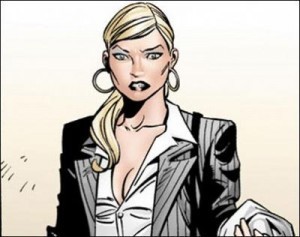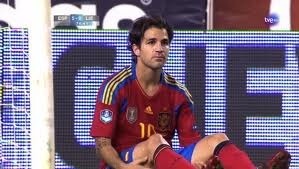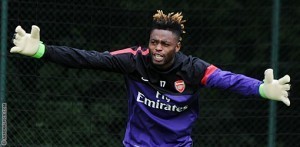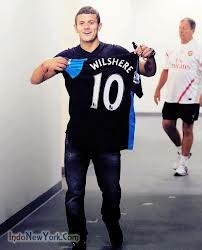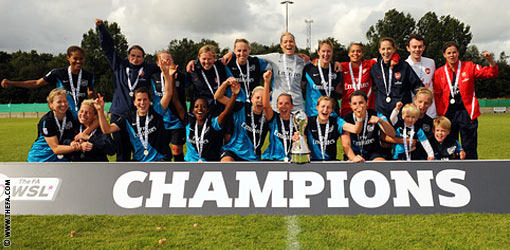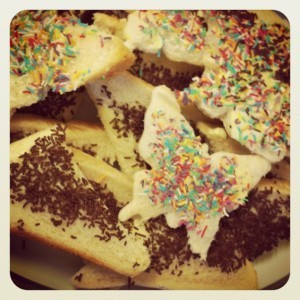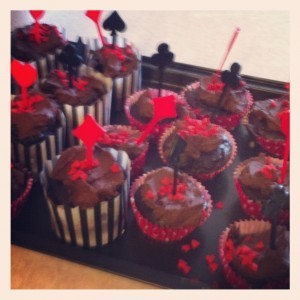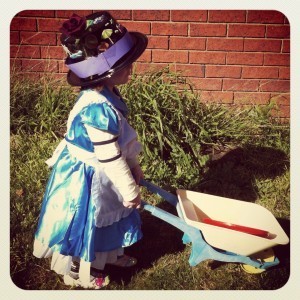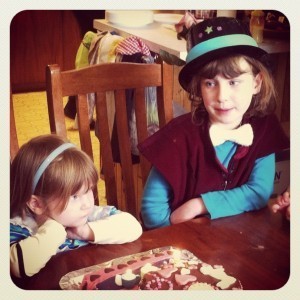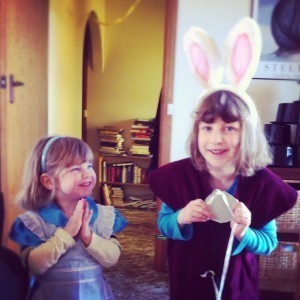Tansy Rayner Roberts's Blog, page 103
August 21, 2012
Book Week: Modern School Days, or do you remember TV tie-in novelisations?
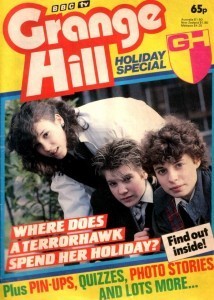 For the most part I think I’ve managed to use this blog to expose pretty much every obsession I’ve been through in my past and present, but there are always a few which slip through the cracks. For instance, I’m pretty sure I’ve never touched on my deep and detailed history of obsessing about Grange Hill.
For the most part I think I’ve managed to use this blog to expose pretty much every obsession I’ve been through in my past and present, but there are always a few which slip through the cracks. For instance, I’m pretty sure I’ve never touched on my deep and detailed history of obsessing about Grange Hill.
It’s pretty easy to be a geek about Doctor Who, or superheroes, or fantasy novels, or even history. But the more mainstream/genre-free a piece of culture is, the harder it is to, for instance, collect merchandise and be madly, publicly geeky about it.
I first became aware of Grange Hill through my childhood in the 80′s. It was a British TV series set in a London comprehensive school, which started in the year I was born an ran for 30 years. It was harder to obsessively follow TV in those days, but I did my best! I seem to recall that sometimes at least a whole season would run on the ABC through the school holidays.
The first year I am certain that I watched was Season 8, which introduced first year characters Gonch, Calley, Ronnie and Hollo (my generation of students!) but still featured older characters who had been around for a while like Stewpot, Claire and Zammo. Some time around then, the series “Tucker’s Luck” also screened, a sequel which followed up the very first students who were the protagonists back in 1978, particularly Tucker (Todd Carty). I remember watching this with my Mum.
But what has this to do with books, you ask? EVERYTHING.
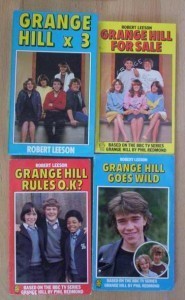 With no video releases and repeats, no fan clubs or programme guides like there was for Doctor Who (NO INTERNET), the only way I could find out more about the characters and history of this show was through books. Mostly written by series creator Phil Redmond, Robert Leeson or Jan Needle, 1-2 tie in novels a year had been released, some of them novelising episodes, or retelling several adventures in a meta kind of way, like through diary entries or adding extra anecdotes. More commonly, they told the story of what the kids got up to in the holidays, and I adored them. I collected them whenever I could, and otherwise read them over and over from the library. I remember particularly prizing my copy of Ziggy’s Working Holiday, and being devastated when a friend I lent “Grange Hill Graffiti” to never returned it.
With no video releases and repeats, no fan clubs or programme guides like there was for Doctor Who (NO INTERNET), the only way I could find out more about the characters and history of this show was through books. Mostly written by series creator Phil Redmond, Robert Leeson or Jan Needle, 1-2 tie in novels a year had been released, some of them novelising episodes, or retelling several adventures in a meta kind of way, like through diary entries or adding extra anecdotes. More commonly, they told the story of what the kids got up to in the holidays, and I adored them. I collected them whenever I could, and otherwise read them over and over from the library. I remember particularly prizing my copy of Ziggy’s Working Holiday, and being devastated when a friend I lent “Grange Hill Graffiti” to never returned it.
In 1988 Phil Redmond’s Official Grange Hill Companion was released (still a prized book in my library!) and I was finally able to fill in the blanks as to what my beloved characters from the early years looked like, and what their story arcs had been when they weren’t on holiday. Until the DVD release of the first four seasons a few years ago (which sadly has not extended to the rest of the show’s run, I assume cos I’m the only one who bought them), that book and the novelisations were Grange Hill for me.
But what was the appeal? I’d always been drawn to and interested in British culture, because that was where my Mum came from, and because she generally refused to let me watch anything but British shows because American and Australian TV annoyed her (hard to argue with, but it meant I came VERY late to A Country Practice, and had a faintly English accent through my primary school years). And maybe part of me realised that the ratbag London kids getting into scrapes and dodging homework were a lot closer to present reality than anything that Enid Blyton, Agatha Christie or yes, Doctor Who, had to offer. (I was also weirdly obsessed with EastEnders, also the point of collecting novelisations, but that was harder because the show stopped being screened in Australia after the first 5 years or so)
Also, I had deep serial loyalty. It’s something I’ve long since accepted about myself, and find it hard to unlearn despite the fact that it’s not nearly as true in my 30′s as it was for my entire life up to the point I had children, but I couldn’t walk past a soap opera without being addicted for a year, couldn’t quit reading a comics series until EVERY CHARACTER I LOVED had left or been killed off, and when I liked a show, I needed to know every little detail about it, so would collect obsessive trivia.
If the internet had been invented back then, possibly I would have learned to let go a little earlier. But story addiction was my favourite thing, and I embraced it deeply. Even to the point of reading amusing novelisations of TV series I had never watched, which is certainly true of the early Grange Hill years – not even the teachers were the same by the time I had started watching! But I cared deeply about the half-told romances, the loyal friendships, the misery and rivalry and bullying.
In 1989 I went to England for the first time, spending a few weeks in London and a couple of months living in Leeds. Apart from the awesome television, the experience of a snow-and-mistletoe Christmas, and the grand squares, hotels and museums of London, a lot of the detail I recall has to do with newsagent’s. I bought comics and magazines galore, inhaling the pure difference of them, of their ads and their stories and yes, Grange Hill comics. Grange Hill comics were the BEST.
Later, in 1991, we returned to England and I actually went to a real London comprehensive for a while. As it turned out, Grange Hill had been right on the money as far as what British schools looked and acted like, though I will admit we had fewer dramas involving asbestos, swimming tragedies or drug overdoses, and would you believe NO teachers fell in love with their students that year? Still, the flavour had been captured perfectly, and so I never felt quite as unsettled or alienated as I otherwise might have. It was all so FAMILIAR to me.
The show itself had passed its heyday by then, I seem to recall, most of my favourite characters were long-gone and I wasn’t as invested in it, though I did crow about finding Press Gang novelisations in a bookshop (again, still prized possessions!), and I never got bored with buying British magazines.
I also found myself utterly obsessed by the concept of the TV novelisation that year – I’d been reading them all my life, not just Grange Hill or Doctor Who but just about everything I could get my hands on, and I remember in that London apartment, attempting to turn the brand new Press Gang episodes into new novelisations of my own (the books I’d bought covered the previous season, the one I’d missed by skipping countries). I had forgotten that! I kept stopping and starting the video to capture the next bit of dialogue.
Later, I’m pretty sure that eBay was invented specifically so that I could replace my copy of Grange Hill Graffiti. I feel so much better for having it back where it belongs. And the TV novelisation is now all but dead as a genre now that we have DVDs and shows on demand (though they do turn up from time to time – with kids TV if nothing else). I still want to write one.
Maybe someday I will.
====
So many other Book Week posts!
Story Spinner Liz has written about Imitating Enid, Books about Schools, and Books About Ponies.
I so missed out on the pony phase, but I probably made up for it by going through the teen romance phase about three times over, starting from when I was 10 or so. Plus, you know, I had a lot of Grange Hill novelisations to read.
Hoyden About Town have got in on the challenge, with Mindy talking about that Blyton lady (she got under ALL of our skins, right?) and Mary talking about Australian classics Playing Beatie Bow and Looking For Alibrandi.
Terri wrote about the glorious gaming experience of Choose Your Own Adventure novels, while Tehani wrote about Black Beauty, teen romance and all manner of other eclectic reading habits from her childhood.
Book Week: Google Buns and Midnight Feasts
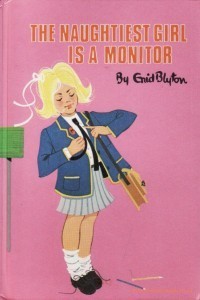 So, Enid Blyton. I don’t even know where to start with talking about Enid Blyton books, and the influence they had on my reading as a child. I know that I was reading chapter books early enough that I don’t recall starting, and that when I was 4-5 my Dad moved away for a year and sent me a book a week – Blyton paperbacks, for the most part. I remember walking to the Post Office to collect my regular parcel!
So, Enid Blyton. I don’t even know where to start with talking about Enid Blyton books, and the influence they had on my reading as a child. I know that I was reading chapter books early enough that I don’t recall starting, and that when I was 4-5 my Dad moved away for a year and sent me a book a week – Blyton paperbacks, for the most part. I remember walking to the Post Office to collect my regular parcel!
I know that I read and loved the mystery and adventure books – The Famous Five, the Secret Seven, The Adventure Of and The Mystery Of – and those characters and stories are deeply entangled in my heart. I also loved the random children books, and the various Toy stories, especially Amelia Jane (I think I was always a bit old for Noddy). But thanks to some world travelling in my mid-childhood years, I sold almost all of my collection, and the ones I cared about enough as an adult to re-acquire were not those ones at all.
Instead, the Blyton books I was most desperate to own again, and to reread, were the school stories and the magical classics: Malory Towers, St Clares, Naughtiest Girl, Faraway Tree and the Wishing Chair.
I read most of the school stories in paperback, just like the mysteries (most books I owned were second hand) but the editions I most recall are the chubby little Dean & Sons 1970′s hardbacks with bright covers, and now I can’t go past them when I see them on a shelf. I have a particular fondness for the font and layout of these books as well as the internal illustrations, and was so excited when I found recent omnibuses of the Faraway Tree and Enchanted Wood books with the original typesetting. None of these modern interactions with Beth and Fran instead of Bessie and Fanny in THIS house! (though I will admit when reading them to my children I did hesitate as to whether I should censor the word ‘queer’).
Both The Faraway Tree and the Wishing Chair have brilliant premises which allow for regular travel to magical lands, and marvellous adventures that have the potential to go dreadfully (but not too dreadfully) wrong. The Faraway Tree, with its gateway to an always-changing cornucopia of strange and magical wonders.
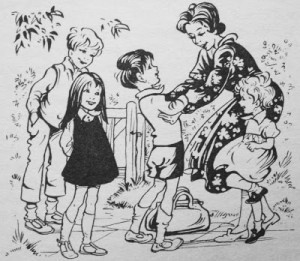 Then of course it had the lovely community in the tree itself, their delicious and improbable food (Google Buns and Pop Biscuits!), and their funny interactions. The whole thing is basically a set up for a sitcom. One of the elements I probably appreciate more now than I did as a child is the way that the children’s mother is gradually pulled into their adventures, because you know it’s quite ODD that your kids spend all this time with friends you’ve never met. Of course she needs to take tea with Moon-Face and Silky!
Then of course it had the lovely community in the tree itself, their delicious and improbable food (Google Buns and Pop Biscuits!), and their funny interactions. The whole thing is basically a set up for a sitcom. One of the elements I probably appreciate more now than I did as a child is the way that the children’s mother is gradually pulled into their adventures, because you know it’s quite ODD that your kids spend all this time with friends you’ve never met. Of course she needs to take tea with Moon-Face and Silky!
I don’t know why the boarding school stories were the ‘real world’ Blytons that resonated with me most. The all girl cast, maybe? But they fascinated me with their French lessons, midnight fests, tempestuous girls and their insane energy for sports. I still feel deeply connected to the game of lacrosse despite never having seen one in person.
Raeli is once again fascinated with the world of the very communist Whyteleafe School, where the Naughtiest Girl attends – she knows we read the first of these together a couple of years ago but doesn’t remember anything of it which is a shame. (Likewise she doesn’t remember the time I first tried to introduce her to these books, in which the concept of boarding school itself was so horrifying that refused to go near the book again for months.
Now of course she is asking covert questions about whether boarding schools are real and um, anything like the ones in the books, with a certain light in her eyes. As if I would let her go! (also, oddly, the Blyton she has discovered and read entirely on her own is Mr Twiddle, one I never would have thought of recommending to her)
This recent article by Jacqueline Rayner in the Guardian about the history of English girl comics reminds me of the comics and annuals I used to read at the same time, acquired in sheafs from various markets and op shops – many of them building on this odd, fantastical image of posh British girls boarding schools with their horses, big matches, teachers called Ma’mzelle, and midnight feasts at which a tin of pineapple would be the ultimate decadent treat.
Is it any wonder that I was a sucker for Harry Potter when it came out?
====
So many great links to other people’s posts about their childhood reading this week:
Random Alex remembers reading Lord of the Rings, and Riddle of the Trumpalar.
Faith Mudge remembers the effect that The Hobbit had on her as a child. I so read that book far too late in life!
Celia views her childhood reading through the lens of what books she most wants to share and pass on to her new baby son. Once we have kids, even the books we loved are not our own any more! (warning to all: it is far more emotionally painful than it should be when they reject the books we want them to adore!)
Terri looks at Nancy Drew, and why she was always far superior to the Hardy Boys.
Keep sending me your links! I’m loving reading these posts, which is why I decided to link to them with each of my posts instead of saving them up for the end.
August 19, 2012
Book Week: Messing About In Boats
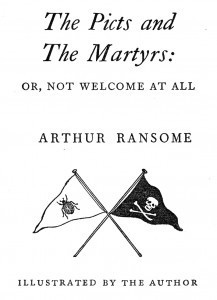 Arthur Ransome is one of the authors who defines my childhood. They were important books to my Dad, and he made sure I had my own copies of them – solid paperbacks using Ransome’s own, amateurish but charming internal illustrations on the cover.
Arthur Ransome is one of the authors who defines my childhood. They were important books to my Dad, and he made sure I had my own copies of them – solid paperbacks using Ransome’s own, amateurish but charming internal illustrations on the cover.
I’m not sure why I started with Coot Club (1934) and The Big Six (1940, but I have a vague feeling that a TV series was responsible. The first book tells the story of studious brother and sister Dick and Dorothea, who go to stay with a family friend in a houseboat on the Norfolk Broads, make friends with the local kids, and get involved in protecting the eggs of local birds from careless holidaymakers as well as overt thieves. Historical environmentalism! The sequel is about how their friends, the Death-and-Glories, are framed for a crime, though I remember it mostly for the scene in which one of them has a wobbly tooth and uses the string-and-door trick. Ouch!
I don’t know why these stories appealed so much, as I was very much an anti-swimmer as a kid and wasn’t overly keen on boats – the one time I went out in one I got scared silly just getting to the damn thing, and I’m pretty sure I impaled my leg on a fish hook.
But it was the characters, of course – for me, it’s always the characters. Clever Dick and Dorothea, and their boat-mad friends, heroic Tom, the elegant blonde twin girls known only as Port and Starboard, and the rough-and-tumble Death-and-Glories completely captured my imagination.
But I remained skeptical about the rest of the series. Next I read The Picts and the Martyrs (1943), another Dick and Dorothea book, only one set at another holiday destination, the Lake District in Cumbria. This was a joyous book as well, all boats and horrible aunts, madcap adventures and two girls, Nancy and Peggy Blackett, who are PIRATES I tell you and thus shouldn’t have to wear pretty dresses and put up with aunts.
I was hooked.
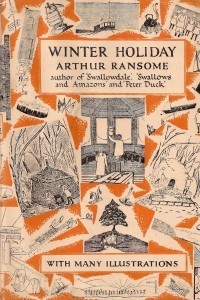 Back at the beginning of the series, to my surprise and frustration, it wasn’t from the point of view of my beloved D’s or Amazons at all, but some kids called Walker with their boat the Swallow… And, oh. The boats, the boats. The strange wild combination of real adventures and make believe. The war between the Swallows and the Amazons, who want the same camping ground, but swiftly realise that they are kindred spirits. The poor uncle who just wants to write his damned book, but finds himself undersiege by his horrid nieces who are determined to make him play pirates with them, no matter what.
Back at the beginning of the series, to my surprise and frustration, it wasn’t from the point of view of my beloved D’s or Amazons at all, but some kids called Walker with their boat the Swallow… And, oh. The boats, the boats. The strange wild combination of real adventures and make believe. The war between the Swallows and the Amazons, who want the same camping ground, but swiftly realise that they are kindred spirits. The poor uncle who just wants to write his damned book, but finds himself undersiege by his horrid nieces who are determined to make him play pirates with them, no matter what.
Children don’t have childhoods like this any more. Maybe they never did. Because ‘if not duffers won’t drown’ is all very well but I’m sorry, my kids are NOT going to be given free rein, a sailboat and a frying pan from the age of seven.
So much of my cultural stash and love of this time period comes from these books. Campfires and milk straight from the cow, tarns and moors, pirates and sailing boats, the taste of cooked eel, the smell of charcoal, girls in red caps and boys who keep promises to their mothers. Mining for gold. Walking across mud flats. Pigeons. Snow. Mumps. Semaphore and other codes. Travelling to the North Pole. Did I mention PIRATES?
But these are also the books that taught me about meta. Because the one I could never finish was Peter Duck. I knew full well that Peter Duck was an imaginary character made up by one of the kids, so when I started reading the book where he was a real person interacting with the Walkers, my brain threw me right out. I’ve still never read that one. Why would I? It obviously never happened.
(It was suggested to me in later years that Missee Lee, the story in which they are all kidnapped by Chinese pirates, is also a ‘pretendy’ adventure. LIES.)
As an adult, Nancy Blackett is the character who has stayed with me. The girl who didn’t want to be a lady, because she was a PIRATE. Fearless, bold and ruthless. How did she grow up? What did the world hold for a woman with that much crazy, untapped imagination?
The world of Cumbrian lakes and messing about in boats was as alien to me as Narnia or Oz, and I lapped it up. I read them over and over, and got more out of them each time. These books are embedded in my veins.
===
A few people have already risen to my challenge of posting about favourite childhood books this week! Check out Terri on Enid Blyton and Thief of Camorr on inspiring books.
Where the Wonder Women Are: #17 Emma Frost
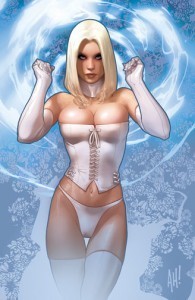 I still don’t feel like I entirely have a handle on Emma Frost. She’s certainly a fascinating, complex individual, and I like a great deal of how she has been written over the years – why is it that all the ‘started out as a villain’ heroes are so interesting? Maybe I just answered my own quesion. I think part of the reason that I still feel like she’s a ‘new’ character (to me) is that like Kitty Pryde (another one I’ve really only come to read about and understand in the last year), she didn’t feature in the 90’s animated series of the X-Men which was for a long time my only introduction to Marvel’s comic characters.
I still don’t feel like I entirely have a handle on Emma Frost. She’s certainly a fascinating, complex individual, and I like a great deal of how she has been written over the years – why is it that all the ‘started out as a villain’ heroes are so interesting? Maybe I just answered my own quesion. I think part of the reason that I still feel like she’s a ‘new’ character (to me) is that like Kitty Pryde (another one I’ve really only come to read about and understand in the last year), she didn’t feature in the 90’s animated series of the X-Men which was for a long time my only introduction to Marvel’s comic characters.
She wasn’t in X-Men Evolution, either, though I think the Mystique portrayal in that cartoon (as the headmistress of a rival school) owed a lot to Emma. She wasn’t in the original three X-Men movies which again served as a re-introduction to the characters for me. More recently, she did appear in the cartoon Wolverine and the X-Men in a splendid version where she gets to be aloof, bitchy, posh and mysteriously helpful to a bunch of untrusting X-Men, which sums her character arc up beautifully. Meanwhile in the movie X-Men First Class, she appears played by January Jones in a quite dreadfully written part that goes through the motions of Emma Frost, but never gives her a chance to do much more than model the outfit.
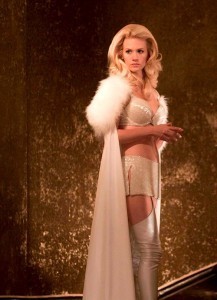 Oh, the outfit. I have a problem with the outfit. There’s a danger in criticising the dress sense of super heroines that you end up blasting or dismissing the characters – and that’s completely out of order because while we as fans have to wrap our heads around why that character would choose that outfit, the fact is that they didn’t.
Oh, the outfit. I have a problem with the outfit. There’s a danger in criticising the dress sense of super heroines that you end up blasting or dismissing the characters – and that’s completely out of order because while we as fans have to wrap our heads around why that character would choose that outfit, the fact is that they didn’t.
Even the artists didn’t choose the outfit for the most part, though they have a lot to do with how that outfit is presented and whether they are going to be part of the problem or part of the solution.
No, the costumes are chosen/approved by those in power – the executives at the company. And just like that, the fact that so many women are running around fighting crime in their underwear IN OUTFITS CHOSEN FOR THEM BY THEIR MALE BOSSES (and to appease the male fans who cry murder if a new costume is mooted) becomes distinctly creepy. Context is everything, though, and as a long term comics reader I have (mostly) come to terms with the sexytimes spandex/fishnets/knickers outfits as part of the tradition of the series.
 Where I object to it most is where the costume – or the artist’s presentation of the costume – breaks the character. Huntress baring her midriff breaks her character. Black Canary wearing her fishnets and no skirt to answer the door ESPECIALLY breaks her character. Bruce Wayne doesn’t wear the Batsuit to the gym. Clark Kent doesn’t wear his tights when lounging around the house. Captain America does not wear the mask when eating his breakfast cereal. And yet the women of superhero comics so often continue to wear the most sexualised elements of their crime-fighting outfits in casual or even work situations where they are deeply inappropriate.
Where I object to it most is where the costume – or the artist’s presentation of the costume – breaks the character. Huntress baring her midriff breaks her character. Black Canary wearing her fishnets and no skirt to answer the door ESPECIALLY breaks her character. Bruce Wayne doesn’t wear the Batsuit to the gym. Clark Kent doesn’t wear his tights when lounging around the house. Captain America does not wear the mask when eating his breakfast cereal. And yet the women of superhero comics so often continue to wear the most sexualised elements of their crime-fighting outfits in casual or even work situations where they are deeply inappropriate.
I can buy Emma’s all white lingerie dominatrix outfit in her role as 1980 villainess, the White Queen of the Hellfire Club. It was actually quite appropriate for both the era and the role she played. But it’s thirty years later, and she’s not an exotic dancing crime lord anymore. I can MAYBE buy her wearing that same outfit as a superhero, to fight crime in (and/or the slightly altered version in which she gets skintight, lowcut white leggings and a bra instead of an actual knickers-stockings-cami set). After all, her open sensuality unsettles people, she is (mostly) invulnerable and as a telepath there is a high chance that she’s always looking at people in their underwear anyway (oh wait, that’s x-ray vision). But when she is also wearing it in business meetings, at the SCHOOL SHE RUNS, and in tactical war rooms, I call foul.
 Also it’s a little confusing that Emma Frost continues to wear the same white lingerie uniform in bed, specifically while seducing her boyfriend. Seriously. Isn’t he a little immune to it by now? If she’s going to put the sexy moves on him deliberately, surely a little variety wouldn’t hurt.
Also it’s a little confusing that Emma Frost continues to wear the same white lingerie uniform in bed, specifically while seducing her boyfriend. Seriously. Isn’t he a little immune to it by now? If she’s going to put the sexy moves on him deliberately, surely a little variety wouldn’t hurt.
Personally I think it would be hilarious if she wore that sexy outfit all day while fighting the mutant war and saving the world, and went to bed in daggy flannel PJs during her ‘time off.’ Doubly awesome if Scott found it hot. Let’s see that, people!
Amanda Conner and John Byrne can’t be the only artists capable of putting a jumper/business suit on their superheroine when appropriate, can they?
But I digress. Clothes are important, but let’s look at the woman behind the white lingerie.
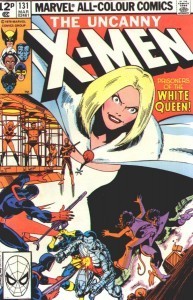 I recently read the Uncanny X-Men story in which she first appeared, back in 1980, already rocking a double life. When we first see Ms Frost, she is a brusque and professional headmistress (IN A BUSINESS SUIT, thank you John Byrne) playing Professor X’s game: locating young mutants and tricking their parents into sending the kids to her school so as to train them to use their abilities (and of course to be loyal minions). This is in no way morally different to what Professor X! Except for the part where she got the information by bugging Cerebro, which I can’t help finding deeply enjoyable.
I recently read the Uncanny X-Men story in which she first appeared, back in 1980, already rocking a double life. When we first see Ms Frost, she is a brusque and professional headmistress (IN A BUSINESS SUIT, thank you John Byrne) playing Professor X’s game: locating young mutants and tricking their parents into sending the kids to her school so as to train them to use their abilities (and of course to be loyal minions). This is in no way morally different to what Professor X! Except for the part where she got the information by bugging Cerebro, which I can’t help finding deeply enjoyable.
Ms Frost makes a play for young teen-with-new-powers Kitty Pryde (also appearing for the first time) but Kitty takes an instant dislike to her, obviously sensing that Professor X and his hip friends Storm and Cyclops will be less of a drag about homework and exams.
By night, Emma Frost is the White Queen of the Hellfire Club, partner to evil lord of evilness Sebastian Shaw, and likes to strut around in the aforementioned white dominatrix gear. It’s a nice touch that when she captures a bunch of X-Men, she strips them to their daks before putting them in cages. Why on earth should she be the only semi-naked person in the room?
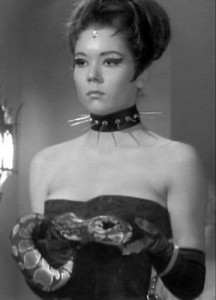 I was intrigued to discover that yes, the Hellfire Club plot and Emma herself were deeply inspired by an episode of The Avengers (the OTHER Avengers, the Steed and Peel TV show from the 1960′s) called “The Hellfire Club” and that her costume was based on the iconic outfit Mrs Emma Peel wears in that episode. Given the Jason Wyndgarde business this shouldn’t have surprised me in the least, and I feel the need to mention that Emma Peel only dressed like this ONCE, whereas Emma Frost has been kept in the same damned outfit for more than thirty years. But knowing she was based on Emma Peel actually makes her even more awesome, and she certainly manages to pull off the classic Diana Rigg move of looking completely untouched and aloof no matter what indignities the plot is perpetuating upon her.
I was intrigued to discover that yes, the Hellfire Club plot and Emma herself were deeply inspired by an episode of The Avengers (the OTHER Avengers, the Steed and Peel TV show from the 1960′s) called “The Hellfire Club” and that her costume was based on the iconic outfit Mrs Emma Peel wears in that episode. Given the Jason Wyndgarde business this shouldn’t have surprised me in the least, and I feel the need to mention that Emma Peel only dressed like this ONCE, whereas Emma Frost has been kept in the same damned outfit for more than thirty years. But knowing she was based on Emma Peel actually makes her even more awesome, and she certainly manages to pull off the classic Diana Rigg move of looking completely untouched and aloof no matter what indignities the plot is perpetuating upon her.
(Fan artists, I would like to see Frost in some other Emma Peel outfits please, along with Cyclops in a bowler hat. MAKE THIS HAPPEN.)
After her first appearance, Emma Frost apparently dies in a suicide run when she realises all is lost, and her place as top lady at the Hellfire Club is quickly taken by a hypnotised Jean Grey (the Black Queen). But Emma’s adventures did not stop there, and she was obviously too cool a character to ditch. Yep, she has officially joined the secret society of death-fakers, population: Everyone.
Emma Frost was a recurring villain for many years, both as the headmistress of rival school the Massachusetts Academy, and as the leader of her graduate student minion super team, the Hellions, who were regular antagonists for the New Mutants, a younger and trendier version of the X-Men.
See? A business suit!
Emma’s role as a teacher and school administrator is vital to her character, and part of what makes her feel so three dimensional, even before she stopped being a villain. Her loyalties were always to herself and her students first, whomever she was allied with next, and everything after that was negotiable. She came regularly into conflict with Professor X and his various teams, of course, but also occasionally allied with them when it was useful. She also found common ground with Magneto, funnily enough.After most of her students were wiped out by Sentinels, Emma was devastated. She later teamed up with Banshee and Jubilee among others in the Generation X series, to reopen the Massachusetts Academy and “protect the next generation of mutants”. Things ended up going horribly wrong for Emma and the team when she was driven to kill her crazy plotting murderous sister (as you do) and hide the crime.
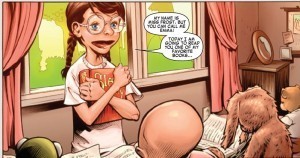 A recentish Origins story started out as a fascinating look at Emma’s childhood as a clumsy, geeky child in a rich, privileged household, and built on how her burgeoning telepathy sabotaged her school life… then skipped ahead to her life as a stripper in the Hellfire Club, apparently about to sleep her way to the top. I thought that was disappointing, and surely didn’t get to the heart of whom Emma Frost is (frankly “I used to be a stripper” isn’t a valid explanation for why she walks around in white underwear all the time if that was the plot, I’m pretty sure most strippers and especially ex-strippers spend quite a lot of time wearing actual clothes).
A recentish Origins story started out as a fascinating look at Emma’s childhood as a clumsy, geeky child in a rich, privileged household, and built on how her burgeoning telepathy sabotaged her school life… then skipped ahead to her life as a stripper in the Hellfire Club, apparently about to sleep her way to the top. I thought that was disappointing, and surely didn’t get to the heart of whom Emma Frost is (frankly “I used to be a stripper” isn’t a valid explanation for why she walks around in white underwear all the time if that was the plot, I’m pretty sure most strippers and especially ex-strippers spend quite a lot of time wearing actual clothes).
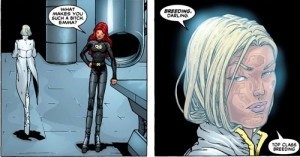 Apparently I was reading the wrong book! If I had followed the early 2000’s Grant Morrison run on X-Men, especially the “Murder in the Mansion” storyline, I would have got far more details about the history of Emma Frost.
Apparently I was reading the wrong book! If I had followed the early 2000’s Grant Morrison run on X-Men, especially the “Murder in the Mansion” storyline, I would have got far more details about the history of Emma Frost.
In 2001, the X-Men titles were all revamped. Emma was teaching again, this time on Genosha, the magical pixie mutant country founded by Magneto. When this sanctuary was destroyed by Sentinels, Emma was found in the rubble, saved by a new secondary mutation, the ability to harden her skin into diamond. Once again, she had lost a school of students and a home. On the bright side, her new power made her a handy substitute for recently-deceased strongman character Colossus, and she was included in the New X-Men team by writer Grant Morrison.
From her new teaching position at the Xavier Institute, Emma attempted to help Scott “Cyclops” Summers with a spot of telepathic therapy which quickly turned into telepathic saucy times. He was still married to Jean at the time so, oops.
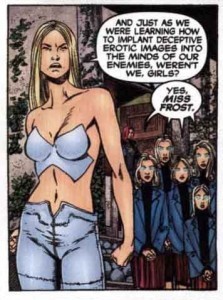 Emma also bonded closely with a group of telepathic quintuplets, the Cuckoos, who became her prize pupils. But when one of them died, the others blamed Emma and took revenge by letting Jean know about Emma and Scott’s affair. It’s all sounding very Days of Our Lives except that Marlena never had the ability to go all PHOENIX on the ass of her latest hubby’s latest lover.
Emma also bonded closely with a group of telepathic quintuplets, the Cuckoos, who became her prize pupils. But when one of them died, the others blamed Emma and took revenge by letting Jean know about Emma and Scott’s affair. It’s all sounding very Days of Our Lives except that Marlena never had the ability to go all PHOENIX on the ass of her latest hubby’s latest lover.
Double oops.
In her fury, Jean mentally assaulted Emma, exposing the humiliations and embarrassments of her past, her relationship with her father, her plainness at school and her stripper years (baaaackstory ahoy!). Later, Emma was found in broken diamond pieces, and Jean was suspected of the murder. The mastermind was later revealed to be Esme Cuckoo. Yes, one of the Cuckoos was evil! But Emma wasn’t dead after all, and the Phoenix restored her.
The best thing I take from this storyline is that in her diamond form, Emma’s weak spot is her nose. Yes, really. Given that the story also reveals she had a nose job in her teens… are these two facts aligned?
Another look at Emma’s background, her wealthy-screwed-up-family and her high school/college years, was told in an ongoing Emma Frost series which ran for 18 issues from 2003. Among other things, it explored the troubled jealousy-blackmail-revenge relationship she had with her sister Adrienne, which later escalated so badly that Emma ended up killing her.
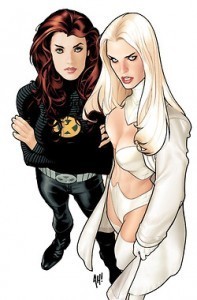 But do you want to hear the really screwed up part? After Jean dies, Scott’s inability to get over his guilt and move on romantically with Emma is shown to be responsible for the creation of a dystopian alternate future. Yep, no more grieving in your own time for YOU, Scotty boy, or the Hunger Games will descend. Most of the X-Men think this is a load of old cobblers and are very judgemental when Scott and Emma start shagging in a real bed, instead of inside each other’s heads.
But do you want to hear the really screwed up part? After Jean dies, Scott’s inability to get over his guilt and move on romantically with Emma is shown to be responsible for the creation of a dystopian alternate future. Yep, no more grieving in your own time for YOU, Scotty boy, or the Hunger Games will descend. Most of the X-Men think this is a load of old cobblers and are very judgemental when Scott and Emma start shagging in a real bed, instead of inside each other’s heads.
We’re up to the Joss Whedon bits now, hooray! At the time that Whedon took on the Astonishing X-Men with artist John Cassaday, Professor X had buggered off somewhere and Emma Frost was running the Xavier Institute as headmistress, sharing the duties with Scott. Well, we say sharing, but I bet we all know which of them is actually qualified for the administrative job and which one spends a lot of time teaching ‘danger’ class and fighting with Wolverine, don’t we?
The Whedon/Cassaday run was my actual first introduction to Emma’s character – I don’t count the X-Men First Class movie in which she is insufferably wet – and I fell in love with her. She’s sharp, snarky, bitchy and competent, and yes her outfit is SO stupidly inappropriate, but she always looks so aloof and self-confident that she might as well be wearing a business suit.
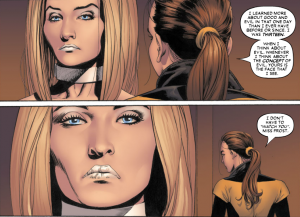 You know what? She would rock the business suit. She’ll still be sexy if you let her wear some CLOTHES, Marvel!
You know what? She would rock the business suit. She’ll still be sexy if you let her wear some CLOTHES, Marvel!
I particularly enjoyed Emma’s tense relationship with a resentful Kitty Pryde, and the levels of trust/distrust various characters feel for her, and she feels for them. There is no ignoring of emotional baggage here – Emma is a telepath, and emotional baggage is her comfort zone.
I’m not going to untangle the Whedon plot run because if you haven’t read it, I don’t plan to spoil the twists and turns like I do for everything else. Go read it! Emma’s arc is one involving betrayal, true love, redemption, bitchiness, and a whole bunch of teaching moments. Because she is first and foremost a teacher.
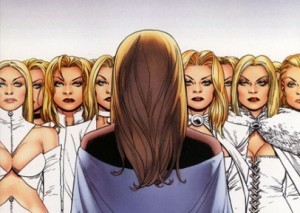 She’s also a mother, thanks to the revelation in the Phoenix-Warsong mini-series (2006) that her ova were used to create all manner of telepathic clones, including the cuckoos. Thousands more of her clone children are killed by the Phoenix entity (not Jean Grey) in this story, leaving Emma angry and swearing revenge.
She’s also a mother, thanks to the revelation in the Phoenix-Warsong mini-series (2006) that her ova were used to create all manner of telepathic clones, including the cuckoos. Thousands more of her clone children are killed by the Phoenix entity (not Jean Grey) in this story, leaving Emma angry and swearing revenge.
Trust issues are a continuing theme of Emma Frost’s life with the X-Men, her relationship with Scott, and pretty much every story she appears in. I have missed a whole bunch of storylines, including the destruction of the Xavier Institute and a whole new war on mutants (or three), but only this week read the X-Men Schism mini-series which addresses, basically, the breakup of Cyclops and Wolverine – the point at which their philosophies reach breaking point.
The story forces a separation between those X-Men willing to stay under Cyclops’ leadership in the newly formed country Utopia, and those leaving with Wolverine to restart the Xavier Institute and protect the new generation of mutants instead of encouraging them to become soldiers right this second. Once the story itself is done, there is a final issue, Regenesis, which looks at many of the intimate conversations that occurred while those choices were made.
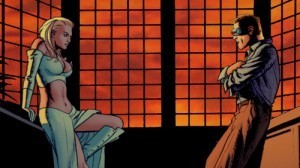 Emma’s is particularly interesting to me. She calls Scott on his assumption that she was going to choose him, and reminds him that Wolverine’s new brief – to teach and protect the kids – is her own vocation and priority. She also points out that while they will still have young people on Utopia for her to take care of, there is a massive difference between teaching and training, and she knows which she’ll end up doing.
Emma’s is particularly interesting to me. She calls Scott on his assumption that she was going to choose him, and reminds him that Wolverine’s new brief – to teach and protect the kids – is her own vocation and priority. She also points out that while they will still have young people on Utopia for her to take care of, there is a massive difference between teaching and training, and she knows which she’ll end up doing.
I really like the fact that this aspect of Emma – her career and her loyalty to the education and protection of children – has been preserved for so long. No matter what else goes on, how many love dramas she survives or bitchy comments she makes, how many times she accidentally betrays the team, or wears white underwear in a war zone, Emma Frost is a teacher and a headmistress, and she’s damned good at that job. She hasn’t given up on her commitment to education, even though her students keep getting killed and breaking that diamond heart of hers.
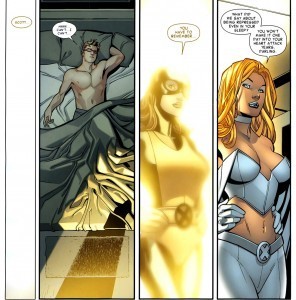 She’s so much more than the blonde who stole Jean Grey’s husband. Though she totally did that. But it should be put on record that a) he wanted to be stolen and b) she is AWESOME at stealing husbands, just as she is awesome at almost everything she turns her hand to.
She’s so much more than the blonde who stole Jean Grey’s husband. Though she totally did that. But it should be put on record that a) he wanted to be stolen and b) she is AWESOME at stealing husbands, just as she is awesome at almost everything she turns her hand to.
Emma stayed with Scott after the Schism and Regenesis. She was always going to stay with Scott, and bankroll his stupid mission, and put up with him naming someone else as his second in command. But she really, really didn’t want her dumbass boyfriend to take her for granted.
He needs to understand that she’d rather be somewhere else, teaching school.
In her underwear, apparently.
Where the Wonder Women Are:
0: Introduction
1: Black Canary
2: Rogue
3: Hawkgirl/Hawkwoman
4: Black Widow
5: Wonder Girl
6: Captain Marvel
7: Vixen
8: Abigail Brand.
9. Jubilee
10. Batwoman
11. Catwoman
12. Huntress
13. Robin
14. Batgirl
15. Jean Grey
16. Ice
August 18, 2012
Book Week Blog Challenge!
It’s the Children’s Book Council of Australia’s Book Week which means that across the country, primary schools are gearing up for a bunch of fun reading activities, culminating in book parades where kids get to dress up as characters from their favourite books.
Heh which in practice means that they figure out who they want to dress up as (princesses and Batman) and then try to find a book that fits it. BUT NEVER MIND THAT.
I decided this year I want to do something fun on the blog to celebrate Book Week, as I usually forget about it until it’s too late. So I’m going to write some posts about my childhood reading, not only favourite books, but how I read them and why I still remember them.
If anyone out there wants to join me in blogging about their childhood in books, please let me know about your posts, either in comments, by Twitter (@tansyrr) or via email to tansyrr (at) gmail dot com. I’d love to be able to do a round up next weekend of various people blogging about their childhood reading and the books that made them happy.
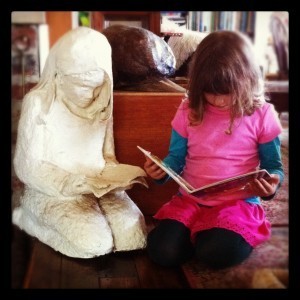
my daughter age 7 reading beside a papier mache portrait my mother made of me at the same age – we never got a perfect photo of me with the statue because by the time she had completed it, I had grown several inches!
Up the Arsenal!
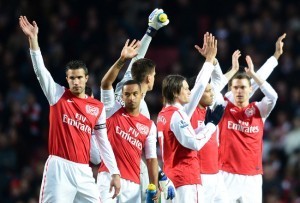 Football is back! I wasn’t expecting it quite so soon because I’ve spent most of the “summer” with my fingers in my ears going lalalalala. But it’s true, it’s back, it’s another season and baby, it is ON for the Arsenal.
Football is back! I wasn’t expecting it quite so soon because I’ve spent most of the “summer” with my fingers in my ears going lalalalala. But it’s true, it’s back, it’s another season and baby, it is ON for the Arsenal.
The story so far!
Last summer, our beloved boy captain, Cesc Fabregas, broke our hearts by abandoning us for Barcelona, his home team, for a big wad of cash and the chance to win tropies. As the hurt began to fade, we consoled ourselves that he was always going to go, that the family and peer pressure had been too much for him, that maybe they loved him as much as we did.
(they don’t)
We also consoled ourselves that at least we had Robin, good old Robin Van Persie, the Dutch family man who replaced Cesc as captain, the man we could rely on, the man who finally after years of injuries had one near-perfect season as a striker.
(too bad the rest of the team wasn’t nearly as good, and we came third in the League)
This summer, Robin broke our heart by leaving us. For Manchester United. And a wad of cash. And the chance to win tropies. And… wahhhhh.
Also it is strongly rumoured that Alex Song, the only player on the team to agree with me that the new purple away kit is awesome, may also be on his way out. To Barcelona. SOB. But he hinted at purple hair this season! Don’t take that away from me, Alex! Also the mighty Alexander Dmitri Song Billong song (to the tune of “love lifts us up where we belong) might never again be heard on the Tuesday Club podcast. YOU MAKE ME CRY, ALEX.
So who do we have left to be excited about? Well, there’s our new captain…
Thomas Vermaelen, the Verminator himself. So named because he has that reassuringly slightly-dead look about the eyes as sported by Robert Patrick in T2 – at least, I like to think that’s the reason! Our new captain and for this year at least, he’s loyal as hell.
Then there’s little Jack Wilshere, our new boy wonder – the player we were most looking forward to being dazzled by last season in the wake of our Cescsadness. But a seemingly random injury in pre-season training meant he was gone for the whole year, and we’re still not likely to see him in a game until October. Still, he’ll be wearing Robin’s old Number 10 shirt when he does… Vermaelen has us now, but the Gooners are all pretty deeply invested in the idea that little Jack W is the captain of our future.
(so he’ll be breaking our heart around about 2015, then? I’ll mark it on the calendar)
 Aaron Ramsey – captain of Wales, our young survivor who made it back on to the pitch after a gruesome leg break, and managed to be mildly dull last season. But hey, it never gets old seeing him run around on the grass. And he got an Olympic gold for Great Britain this summer, so maybe that will give him the extra spark he needs!
Aaron Ramsey – captain of Wales, our young survivor who made it back on to the pitch after a gruesome leg break, and managed to be mildly dull last season. But hey, it never gets old seeing him run around on the grass. And he got an Olympic gold for Great Britain this summer, so maybe that will give him the extra spark he needs!
 Andrey Arshavin – our Russian pocket rocket had a slow run last year and powered his way back home to Zenit on a loan. But there’s no sign of selling him and I’ve always had a soft spot for the goofy faces he pulls. Will he go or will he stay? Apparently Russia may not want him any more after he got into a rumpus with fans after their national team crashed out of Euro 2012, but do we want him back? (I WANT HIM BACK) Will he ever score three goals against Liverpool again? Cos next time he does that it would be awesome if we could win the game…
Andrey Arshavin – our Russian pocket rocket had a slow run last year and powered his way back home to Zenit on a loan. But there’s no sign of selling him and I’ve always had a soft spot for the goofy faces he pulls. Will he go or will he stay? Apparently Russia may not want him any more after he got into a rumpus with fans after their national team crashed out of Euro 2012, but do we want him back? (I WANT HIM BACK) Will he ever score three goals against Liverpool again? Cos next time he does that it would be awesome if we could win the game…
 Theo Walcott – another of our boy wonders, this young player has a habit of lurching between brilliance, super-brilliance and ordinariness but when he starts running with those lightning feet of his, the other team tends to freak the hell out, and for a very good reason. Like Robin did, he only has a year on his contract, and hasn’t confirmed yet that he’s re-signing with us. We want to grow old with you, Theo! Don’t leave us now…
Theo Walcott – another of our boy wonders, this young player has a habit of lurching between brilliance, super-brilliance and ordinariness but when he starts running with those lightning feet of his, the other team tends to freak the hell out, and for a very good reason. Like Robin did, he only has a year on his contract, and hasn’t confirmed yet that he’s re-signing with us. We want to grow old with you, Theo! Don’t leave us now…
Then there’s baby-face Gibbs and steady Arteta and occasionally marvellous Rosicky and the OX, who will surely come into his real power as a footballer this season, but most of all there is the wildcard Frimpong, whose tweets are impenetrable and whose gameplay is… erratic, but oh, we can’t take our eyes off him. Don’t change, Frimpong!
Plus we have new signings. Actual new signings. Not our manager Arsene Wenger claiming that getting injured players back from a long hiatus is JUST LIKE a new signing. To be honest I haven’t been keeping track of them all thanks to the lalalala business, but everything I do hear suggests that this is better, this is promising, and there is life after Robin Van Persie.
What’s more, the team will be wearing purple stripes this year which means that every away game will be PURE GOLD.
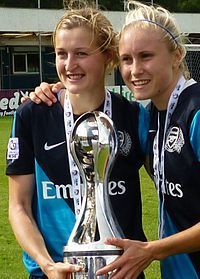 Oh and while our men were knuckle-scraping their way to third place last year, one more year without a trophy and with our best players falling away like depressed lemmings, there’s the Arsenal Ladies, the most successful club in English women’s football, who completed yet another domestic treble last year, winning the FA Cup, the Continental Cup, and the inaugural Women’s Super League. In the 25 years since their team was founded, they have won 34 trophies in all.
Oh and while our men were knuckle-scraping their way to third place last year, one more year without a trophy and with our best players falling away like depressed lemmings, there’s the Arsenal Ladies, the most successful club in English women’s football, who completed yet another domestic treble last year, winning the FA Cup, the Continental Cup, and the inaugural Women’s Super League. In the 25 years since their team was founded, they have won 34 trophies in all.
Most of their games don’t even get FILMED, let alone televised. Because that is women’s sports for you.
Here we go again. FOOTBALL ON!
August 16, 2012
Friday Links Fights Crime Like a Discus Thrower
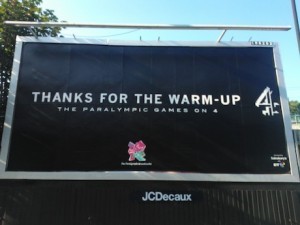 Does everyone else miss the Olympics as much as I do? This week’s Gruen Sweat did a good job of psyching me up for the Paralympics, though. In the mean time, check out some great posts about the Olympics, women and us:
Does everyone else miss the Olympics as much as I do? This week’s Gruen Sweat did a good job of psyching me up for the Paralympics, though. In the mean time, check out some great posts about the Olympics, women and us:
Fit and Feminist looks at the girl love and friendship displayed between the athletes and wonders if there’s a female equivalent of bromance (it’s sromance, actually!).
Meanwhile, Comics Alliance asks the big question – with so many different types of super-fit trained bodies on display across the Olympics, why do superheroes in comics use such limited body types, over and over?
Mayim Bialik comments on the tightly pinned hair of the Olympic gymnasts and wonders about the implications of a sport that doesn’t allow even a hair out of place. I think that the many commenters who talk about the practicality of the hair clips (a stray hair can actually distract you badly) and the problem with bringing attention to the hair of female athletes all have really good points, but at the same time I also think Bialik has a good point about the disturbing message of perfection as a priority that comes from professional gymnastics. (though I still love it and totally consider it a sport, Alex! Mind you, I feel the same way about Masterchef…)
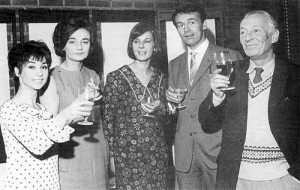 In non-Olympic news, it has finally been confirmed that Mark Gatiss is in fact writing a one-off TV drama to mark the 50th anniversary of Doctor Who, based around the story of the creation of the show itself and featuring characters such as Verity Lambert (the youngest female TV producer of the era), Waris Hussein (the youngest and only Asian director at the BBC), brash show creator Sydney Newman, and of course the actors who brought the early episodes to life. I am fascinated with TV history generally and this is especially exciting – who on earth will they cast as William Hartnell? Will any current Doctor Who actors feature in new roles? (this could totally work, like those wonderful Hercules episodes where Hudson Leick plays Liz Friedman, Robert Trebor and Ted Raimi play Roberto Orzi and Alex Kurtzman, and so on) Eeeee!
In non-Olympic news, it has finally been confirmed that Mark Gatiss is in fact writing a one-off TV drama to mark the 50th anniversary of Doctor Who, based around the story of the creation of the show itself and featuring characters such as Verity Lambert (the youngest female TV producer of the era), Waris Hussein (the youngest and only Asian director at the BBC), brash show creator Sydney Newman, and of course the actors who brought the early episodes to life. I am fascinated with TV history generally and this is especially exciting – who on earth will they cast as William Hartnell? Will any current Doctor Who actors feature in new roles? (this could totally work, like those wonderful Hercules episodes where Hudson Leick plays Liz Friedman, Robert Trebor and Ted Raimi play Roberto Orzi and Alex Kurtzman, and so on) Eeeee!
I can’t find the link right now, but Steven Moffat also confirmed this week that there will be an anniversary Doctor Who story screened on 23rd November 2013 – which has turned out to actually be a Saturday! Who organised that, then?
Sarah Rees Brennan writes a magnificent essay about the women behind Nancy Drew – and how the famous series was constructed. I had never heard any of this before, and was gobsmacked.
Related revelations about the book packaging come from this post about how the Sweet Valley High books were written – hint, not by Francine Pascal! But man, that woman was clever.
Tor.com wants to talk about why we really love Princess Leia.
Oh and Sarah Rees Brennan also manages to make the world feel better about the Prince Caspian movie with this parody.
Jim C Hines posts his thought-provoking personal sexual harassment policy.
A little girl speaks up (yells up!) about a casual sexism drive by – because yes, a complete stranger did think he should be able to inform her that cars are for boys.
The Angriest’s ongoing series of posts about how the DC New 52 have been faring since the reboot has been greatly entertaining and informative but I was particularly keen to see what he had to say about the new/old Batgirl.
Rowena’s new paranormal crime book The Price of Fame is out – I am looking forward to this one, as I read it in manuscript form some time ago and am interested to see how it’s changed. When I read it though, it was a spooky love letter to 1980′s Melbourne culture. I hope it still is!
Sean the Blogonaut interviews Trudi Canavan for Galactic Chat.
via the Mary Sue:
August 15, 2012
Galactic Suburbia Episode 66: Sporty Space
The new episode is up! You can grab it off iTunes or directly from our Podbean site.
 In which we suffer post-Olympics slump but make up for it by talking about sport in SF/F: from coyote baseball, holodeck racquetball and the points system of Quidditch to the history of sport in Doctor Who. And don’t forget that Buffy was a cheerleader!
In which we suffer post-Olympics slump but make up for it by talking about sport in SF/F: from coyote baseball, holodeck racquetball and the points system of Quidditch to the history of sport in Doctor Who. And don’t forget that Buffy was a cheerleader!
News
World Fantasy ballot released.
Mythopoeic Awards include Delia Sherman and Lisa Goldstein
New Science Fiction Awards Database Website by Mark R Kelly (Locus)
Kirstyn McDermott makes Jason Nahrung a mug based on Alex’s GS review of Salvage
New Galactic Chat: Sean interviews Trudi Canavan
Readercon Apology sets the standard.
Feedback: Sean & Kitty on the harassment at cons issue.
What Culture Have we Consumed?
Alex: Existence, David Brin; all of Planetary, by Warren Ellis; Caliban’s War, James SA Corey
Tansy: “Foundlings” by Diana Peterfreund in Brave New Love; Shooting the Poo 14 (Sherlock Holmes) & 15 (Alien movies part 1)
Alisa: Coode St Podcast Ep 112 featuring Genevieve Valentine, and… reading unapologetically is a life skill!
Pet Subject: Sports in SF/F
The tennis match Alisa refers to is this one with Billie Jean King.
Please send feedback to us at galacticsuburbia@gmail.com, follow us on Twitter at @galacticsuburbs, check out Galactic Suburbia Podcast on Facebook and don’t forget to leave a review on iTunes if you love us!
Pratchett’s Women IX: The Truth Has Got Her Boots On
The Truth, by Terry Pratchett
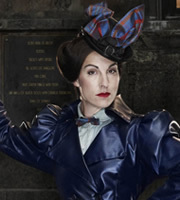 I almost wasn’t going to write a Pratchett’s Women post for The Truth. Like Night Watch, it’s a marvellous book, one of Pratchett’s absolute best, and happens to be almost entirely about male characters and their issues. Considering that gender imbalance is no longer the case for every Discworld novel or even almost every Discworld novel, (as could be argued that it was the case in his earlier days) it feels churlish to criticise it on those grounds. It is a love letter to moveable type, and a fun take on the history of the printing press, with the usual layers of humour and cleverness, and a rich cast of characters, so I am going to forgive it for being a mostly male cast. This was actually the book that brought me back to the Discworld after a period of what felt at the time to be lacklustre releases but may well have been my own loss of interest in the series, and its many repetitions.
I almost wasn’t going to write a Pratchett’s Women post for The Truth. Like Night Watch, it’s a marvellous book, one of Pratchett’s absolute best, and happens to be almost entirely about male characters and their issues. Considering that gender imbalance is no longer the case for every Discworld novel or even almost every Discworld novel, (as could be argued that it was the case in his earlier days) it feels churlish to criticise it on those grounds. It is a love letter to moveable type, and a fun take on the history of the printing press, with the usual layers of humour and cleverness, and a rich cast of characters, so I am going to forgive it for being a mostly male cast. This was actually the book that brought me back to the Discworld after a period of what felt at the time to be lacklustre releases but may well have been my own loss of interest in the series, and its many repetitions.
But I wasn’t alone in that. The Truth was a huge success for Pratchett, and one of the books which really helped to cement his ‘legend’ status. While he had previously written other novels with a similar formula (standalone male character faces the Discworld’s version of a particular historical industry and chaos ensues) there was something about this book, and its maturity, and perhaps the solid link to the history it was replicating that made it popular among non-fantasy readers. In fact, apart from the vampire, Death and the other side effects of a Discworld setting, this is largely not a story about magic gone wrong and trying to kill you, which sets it apart from almost every previous Discworld novel. This is instead a story of PEOPLE gone wrong and trying to kill you, and how a new industry can be every bit as terrifying and confrontational and dangerous as anything from the Dungeon Dimensions.
 Did I mention? This novel is magnificent.
Did I mention? This novel is magnificent.
It could actually be argued that the story of William de Worde and The Ankh Morpork Times is very much a story about gender issues, though William himself is unaware of it. This is at its heart a story about the patriarchy, and how much it screws men up every bit as much as it screws up women. If I was writing a blog series about Pratchett’s Men (and really, someone should) I would talk about the way that traditional masculinity and paternal themes are continually addressed and undercut in this story, which is very much about the Men Who Shape The World and the Legacy They Leave Behind and those sort of themes. This is very much part of the Discworld tradition, which has been subverting narratives of masculinity right from the start through characters like Rincewind and Twoflower, Vetinari, Ridcully, Vimes, Moist Von Lipwig, Cohen the Barbarian and even some of the one-off ‘heroes’ like Pteppic and Victor.
But this is not that blog series. So instead, I’m going to talk about Sacharissa Cripslock.
It’s disappointing to me that Sacharissa is the only full-blooded female character in a sea of mostly invisible women in this story (such as the upwardly mobile wife and daughter of Harry King, William’s sister, the dwarves who might not be male after all, a few absent mothers and so on). Mrs Arcanum the landlady and her Opinions represent an important ongoing subplot, though rather more attention in those scenes is given to Mr Windling and his Opinions – Mrs Arcanum is saved mostly for comic relief. Sgt Angua also makes an important cameo appearance, though she looms larger in the books behind the scenes than actually on the page. There is a running joke based on William’s belief that Nobby Nobbs is the rumoured werewolf in the City Watch, and the reader’s presumed knowledge that in fact it is Angua. But sadly as with her own books, Angua isn’t in this one nearly enough, and most of the interesting things she gets to do happen “offscreen”.
 But Sacharissa is pretty awesome. Apart from the running gag about her boobs (they are mighty and marvellous to behold, by all accounts) and the oft-quoted line about her face being “eclectically attractive,” she is very much part of the story because of her personality, and what a complex one it is. Pratchett seems at his most comfortable when writing intensely pragmatic women, and Sacharissa is very much in this vein. I found it interesting that her primary personality quirk at the beginning of the story was an obsession with historically ladylike behaviour, and what is ‘seemly’ for a lady to do, wear and say (which pretty much puts her on par with Mrs Arcanum). It’s worth noting that while William thinks such beliefs are frivolous and unnecessary, for Sacharissa they’re probably essential survival skills in a world that veers from medieval to Victoriana to modern attitudes and back again at a moment’s notice, and in a city that still thinks calling prostitutes “seamstresses” is highly amusing.
But Sacharissa is pretty awesome. Apart from the running gag about her boobs (they are mighty and marvellous to behold, by all accounts) and the oft-quoted line about her face being “eclectically attractive,” she is very much part of the story because of her personality, and what a complex one it is. Pratchett seems at his most comfortable when writing intensely pragmatic women, and Sacharissa is very much in this vein. I found it interesting that her primary personality quirk at the beginning of the story was an obsession with historically ladylike behaviour, and what is ‘seemly’ for a lady to do, wear and say (which pretty much puts her on par with Mrs Arcanum). It’s worth noting that while William thinks such beliefs are frivolous and unnecessary, for Sacharissa they’re probably essential survival skills in a world that veers from medieval to Victoriana to modern attitudes and back again at a moment’s notice, and in a city that still thinks calling prostitutes “seamstresses” is highly amusing.
The best part is watching the way that Sacharissa steals the novel from under William’s feet. Their romance, if you can call it that, is one of those vague baffled courtships that Pratchett does so often, in which both parties spend the whole time loudly thinking about everything except their attraction to each other, and dance around the subject so subtly that you’re not always sure that he MEANT you think it was a romance at all. But for the most part, Sacharissa isn’t bothered about impressing William or finding herself a bloke – instead she, like William, falls deeply in love with the newspaper business.
This romance is a threeway.
What’s enjoyable is that while most scenes are from William’s point of view, and most of the Sacharissa scenes are translated through his perspective, we still see that her love affair with The Ankh Morpork Times unfolds completely differently to his. She’s the one who spots early on many of the practical essentials of the business, like why you report on meetings with lots of names in them, or how to cover the everyday dull parts of city life, and especially how to craft headlines. While William is figuring out from the ground up how to use concepts like Freedom of the Press, or how to report on big, “weighty” political issues, Sacharissa is working behind the scenes to figure out everything else you need to put in a newspaper so that it is more than just a front page. He’d be lost without her, and it’s nice that by the end he has certainly acknowledged that fact.
 She’s not just doing the grunt work for no recognition, either. While William still fighting against some of the necessities of the printing and news trade, Sacharissa is often several steps ahead of him. All of this competence is shown clearly, and while William does mutter about Sacharissa using her attractiveness to gain news tidbits from eager young men, it’s quite obvious that there is more to her methods than that. She also has the contacts and experience in the printing industry that William lacks – in fact she only became involved with the Times in the first place because she came over to complain at her father the printer being put out of business.
She’s not just doing the grunt work for no recognition, either. While William still fighting against some of the necessities of the printing and news trade, Sacharissa is often several steps ahead of him. All of this competence is shown clearly, and while William does mutter about Sacharissa using her attractiveness to gain news tidbits from eager young men, it’s quite obvious that there is more to her methods than that. She also has the contacts and experience in the printing industry that William lacks – in fact she only became involved with the Times in the first place because she came over to complain at her father the printer being put out of business.
Now that I come to think of it I’m not ENTIRELY convinced that the novel needed William in it at all…
Sacharissa’s character crescendo in The Truth comes as the resolution of another running gag, that of the hardboiled thug Mr Tulip and his method of swearing (mostly saying “-ing” a lot without bothering to fill in the verb). William sends Sacharissa into what looks like a socially awkward situation, giving her the key to his family’s townhouse and permission to raid his sister’s wardrobe for a suitable dress to wear for a ball. This in itself goes against Sacharissa’s instincts about feminine respectability, and she is so busy trying to deal with the fact that she’s effectively burgling a house (because it didn’t occur to him to go with her) that she ends up caught in a far more dangerous situation, facing down two assassins and being used as a hostage.
It’s here that the Lois Lane analogy, which has been a strong implication all along, looms even larger. Being kidnapped by bad guys was an everyday occurrence for the sassy reporter of the Daily Planet, but Sacharissa doesn’t have a pet superhero to rescue her – and so she throws caution and her last vestiges of “respectability” to the wind in order to rescue herself, along with a healthy bout of yelling and swearing, which she finds rather cathartic.
Then of course it’s up to Sacharissa and William to save their mutual true love, the newspaper itself, from disaster…
I enjoy Sacharissa as a very likeable, complicated and useful character in an excellent novel. But I’m not entirely sure what her character is supposed to represent. Is she a satire on a certain old fashioned kind of young lady who needs to loosen her corsets a bit? Is her character arc to be a bit less worried about what people think of her? Is she a feminist character, or a representative of why the women of the Discworld NEED a bit more organised feminism? Mostly I think she’s far too busy to worry about such things.
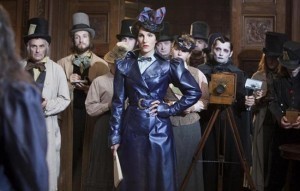 When she turned up again in Going Postal, it was noted that she wore a wedding ring, but continued to call herself “Miss Cripslock”. A nice sign of moving with the times, absolutely. If nothing else, Sacharissa is a great example of a practical woman in a fantasy novel who dresses sensibly and is excellent at her job. Which now I come to think about it, makes her a spectacularly important role model. While there hasn’t yet been a movie or other media adaptation made of The Truth (which is a shame because it would be BRILLIANT), Sacharissa’s passing role in Going Postal (in which she is once again shown doing her job as an investigative reporter quite excellently) means that she has been portrayed on the small screen by the comic actress Tamsin Greig – the casting choice does mean she is about 20 years older than she was portrayed in the books, but considering how briefly she appears that’s hardly important, and the essence of the character as a caller-of-bullshit in modest attire is definitely there.
When she turned up again in Going Postal, it was noted that she wore a wedding ring, but continued to call herself “Miss Cripslock”. A nice sign of moving with the times, absolutely. If nothing else, Sacharissa is a great example of a practical woman in a fantasy novel who dresses sensibly and is excellent at her job. Which now I come to think about it, makes her a spectacularly important role model. While there hasn’t yet been a movie or other media adaptation made of The Truth (which is a shame because it would be BRILLIANT), Sacharissa’s passing role in Going Postal (in which she is once again shown doing her job as an investigative reporter quite excellently) means that she has been portrayed on the small screen by the comic actress Tamsin Greig – the casting choice does mean she is about 20 years older than she was portrayed in the books, but considering how briefly she appears that’s hardly important, and the essence of the character as a caller-of-bullshit in modest attire is definitely there.
Amazingly, on the original book cover, Josh Kirby managed to draw Sacharissa with at least as many clothes on as she is described as wearing in the book. I consider that a triumph of sorts, compared to his earlier work.
Previous posts in this series:
Pratchett’s Women: The Boobs, The Bad and the Broomsticks
Pratchett’s Women II – Slash! Stab! A Lesson in Practical Queening in Lords and Ladies
Pratchett’s Women III – Werewolf Glamour and the Sexing of Dwarves in Guards, Guards!, Men at Arms, Feet of Clay
Pratchett’s Women IV: His Henpecked Voice in Jingo & The Fifth Elephant
Pratchett’s Women V: The Seamstress Redemption in Night Watch
Pratchett’s Women VI: Pole Dancers, Goblin Girls, and the Family Man in Thud and Snuff
Pratchett’s Women VII: A Wonderful Personality and Good Hair – Agnes Nitt Maskerade and Carpe Jugulum
Pratchett’s Women VIII: Has Scythe, Will Teach School – Susan Sto Helit in Soul Music, Hogfather & Thief of Time
August 12, 2012
Happy Alice
 We have survived Jemima’s birthday! I wanted to do something special for her because she missed out on a party last year, as the whole family was sick, and ever since January when half the people she knew had birthday parties, she has been wondering where hers is. A year is a long time between two and three…
We have survived Jemima’s birthday! I wanted to do something special for her because she missed out on a party last year, as the whole family was sick, and ever since January when half the people she knew had birthday parties, she has been wondering where hers is. A year is a long time between two and three…
The Alice in Wonderland theme was, admittedly, my plan because I figured it was one of the last birthdays where I would get to decide the theme instead of having to incorporate whatever crazymadawesome ideas my daughter thought up for herself.
I think I made the right call.
The cake was a two-layered job (first time I think I’ve ever stacked cakes!) with a white rabbit & fob watch dairy & gluten free chocolate mud cake on top, and a Cheshire Cat pink and purple striped butter cake underneath. And yes, that’s a Tick Tock biscuit making the fob watch.
Um. I overestimated the number of people we had coming. There is a LOT of cake left. Still, that is a good problem to have.
Refreshments included a teapot full of juice, jam tarts, and bread-and-butterfly fairy bread.
Also, red velvet cupcakes for the grown ups! Possibly this added to the surfeit of cake, but these at least got entirely eaten, and gave me an excuse to use the suits-of-cards cupcake picks I had also ordered off eBay. (the flamingo drinks stirrers went into the party bags.)
I’ve got into the habit of getting the girls a birthday-party-relevant fancy dress costume each birthday, which is generally a good investment (Raeli’s Wonder Woman costume from several years ago is still well in use, for instance) and could not resist the adorable Alice costume I found for Jem on eBay. The only problem is that the pinafore is basically a weird Moebius strip design which I find impossible to put on her myself. Luckily there’s a physicist in the house!
Raeli, meanwhile, was easily sorted with some white bunny ears, a homemade watch (it says “You Are Late!”) and an old velvet doublet from the wardrobe. Luckily she is keen to recycle the same costume for Book Week later this week. RESULT.
Rather than subject a bunch of parents to such a specific fancy dress option, I decided to make costuming one of the party activities, so as soon as the kids appeared at the door they were settled down with a plastic top hat, and lots of art materials (mostly stickers) to decorate said hat. They all created such gorgeous works of millinery! I would totally do this again for a party. It was especially useful for the Mad Hatter’s Tea Party but I’m sure could be adapted to other themes and the kids were all very attached, happily taking their hats home with them at the end. Kudos to my Mum for helping them all with their masterpieces.
There are so many cute Alice and Wonderland THINGS online, but my most sensible investment was buying rubber stamps instead of stickers – I wanted the girls to be able to decorate invitations and party bags themselves, and this worked really well. I’m quite tempted to get hold of a whole lot more interesting stamps now, so maybe it wasn’t the wise choice after all…
Lots of work beforehand, but it was actually a nice, casual day – my party planning style tends to involve lots of medium sized ideas, most of which can be jettisoned at the last minute. And oh boy, did I jettison many of them as yesterday wore on and it became obvious that I wasn’t going to be able to make mini-quiches, marshmallow teacups or a bunch of other things I thought maybe I would.
Thank goodness for the weather, which enabled us to send the kids outside for several bouts of general play (and indeed many of the adults liked it out there too, which solved the chair problem). I couldn’t face too many party games with three-year-olds. I am pleased to say that the pass the parcel happened with only small amounts of petty jealousy and plenty of good sportmanship. Oh, and we were having such a nice time that everyone stayed nearly 2 hours longer than planned, so we indoctrinated all their children into My Little Pony. Hooray! I *think* we’ve even managed to pull off the ‘house is actually cleaner than it was before we started planning for the party’ trick, too.
But the best part was near the end of the party when my little girl (THREE) jumped into my arms in a heap of cotton and satin and cuddled me. “Tired Alice?” I suggested.
“No, I’m a Happy Alice!” she said.
So proud of her for having a good day. I think Raeli was MUCH older before we managed a birthday party that didn’t involve tears & overwhelmedness.

